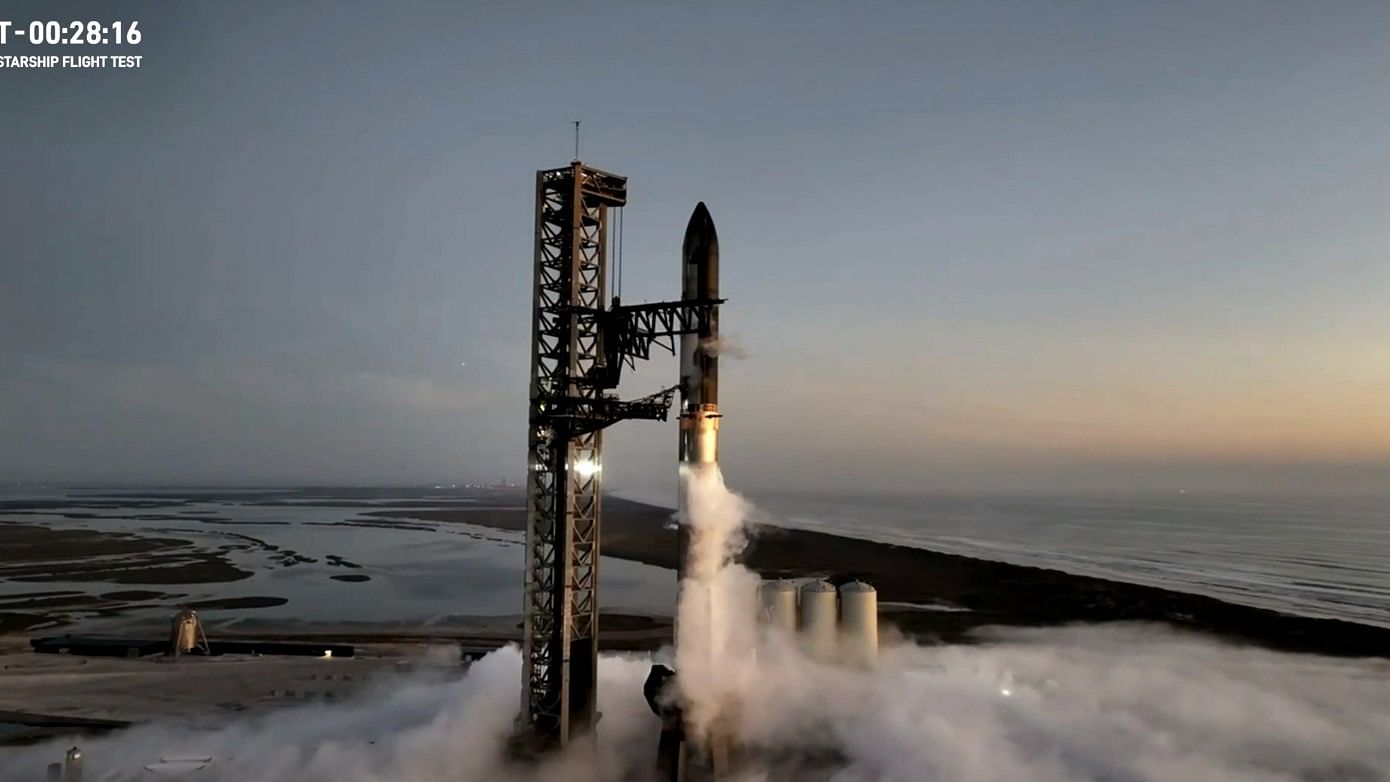
The two-stage rocketship, taller than the Statue of Liberty, blasted off from the Elon Musk-owned company's Starbase launch site near Boca Chica in Texas, east of Brownsville, on a planned 90-minute uncrewed flight into space.
Credit: X/@SpaceX
Texas: SpaceX's next-generation spacecraft Starship, developed to carry astronauts to the moon and beyond, roared into the sky from the Gulf Coast of Texas on Saturday in a repeat test launch seven months after its first attempt to reach space ended in an explosion.
The two-stage rocketship, taller than the Statue of Liberty, blasted off from the Elon Musk-owned company's Starbase launch site near Boca Chica in Texas, east of Brownsville, on a planned 90-minute uncrewed flight into space.
The launch marked only the second attempt to fly Starship mounted atop its towering Super Heavy rocket booster.
A live SpaceX webcast of the lift-off showed the rocketship rising from the launch tower into the morning sky as the Super Heavy's cluster of powerful Raptor engines thundered to life in a ball of flame and billowing clouds of exhaust and water vapor.
The test flight's principal objective was to get Starship off the ground and into space just shy of Earth obit. Doing so would mark a key step toward achieving SpaceX's ambition producing a large, multi-purpose, spacecraft capable of sending people and cargo back to the moon later this decade for NASA, and ultimately to Mars.
Musk - SpaceX's founder, chief executive and chief engineer - also sees Starship as eventually replacing the company's workhorse Falcon 9 rocket as the centerpiece of its launch business that already lofts most of the world's satellites and other commercial payloads into space.
NASA, SpaceX's primary customer, has a considerable stake in the success of Starship, which the US space agency is counting on to play a central role in its human spaceflight program, Artemis, successor to the Apollo missions of more than a half century ago that put astronauts on the moon for the first time.
A successful test flight on Saturday also would make the Starship-Super Heavy combo as the most powerful launch vehicle on Earth, surpassing NASA's own Space Launch System (SLS) rocket and Orion capsule, which flew together for the first time in December 2022.
Starship's towering first-stage booster, propelled by 33 Raptor engines, puts the rocket system's full height at some 400 feet (122 meters) and produces thrust twice as powerful as the Saturn V rocket that sent the Apollo astronauts to the moon.
The mission's objective is to get Starship off the ground in Texas and into space just shy of reaching orbit, then plunge through Earth's atmosphere for a splashdown off Hawaii's coast. The launch had been scheduled for Friday but was pushed back by a day for a last-minute swap of flight-control hardware.
During its April 20 test flight, the spacecraft blew itself to bits less than four minutes into a planned 90-minute flight that flight went awry from the start. SpaceX has acknowledged that some of the Super Heavy's 33 Raptor engines malfunctioned on ascent, and that the lower-stage booster rocket failed to separate as designed from the upper-stage Starship before the flight was terminated.
RISK TOLERANCE
The company's engineering culture, considered more risk-tolerant than many of the aerospace industry's more established players, is built on a flight-testing strategy that pushes spacecraft to the point of failure, then fine-tunes improvements through frequent repetition.
A failure at any point in the test flight would be a major concern for NASA, which is counting on SpaceX's rapid rocket development ethos to swiftly get humans to the moon in the U.S. competition with China's lunar ambitions.
Judging the success or failure of the outcome may be less than clear-cut, depending on how far the spacecraft gets this time. NASA Administrator Bill Nelson, who has made the China rivalry a key need for speed, compared Starship's test campaign with the success of SpaceX's past rocket development efforts.
"How did they develop the Falcon 9? They went through many tests, sometimes it blew up," Nelson told Reuters on Tuesday. "They'd find out what went wrong, they'd correct it then go back."
The combined spacecraft in April reached a peak altitude of roughly 25 miles (40 km), only about halfway to space at its target altitude of 90 miles (150 km), before bursting into flames.
Musk has said that an internal fire during Starship's ascent damaged its engines and computers, causing it to stray off course, and that an automatic-destruct command was activated some 40 seconds later than it should have to blow up the rocket.
The launch pad itself was shattered by the force of the blastoff, which also sparked a 3.5-acre (1.4-hectare) brush fire. No one was injured. SpaceX has since reinforced the launch pad with a massive water-cooled steel plate, one of dozens of corrective actions that the U.S. Federal Aviation Administration required before granting a launch license on Wednesday for the second test flight.